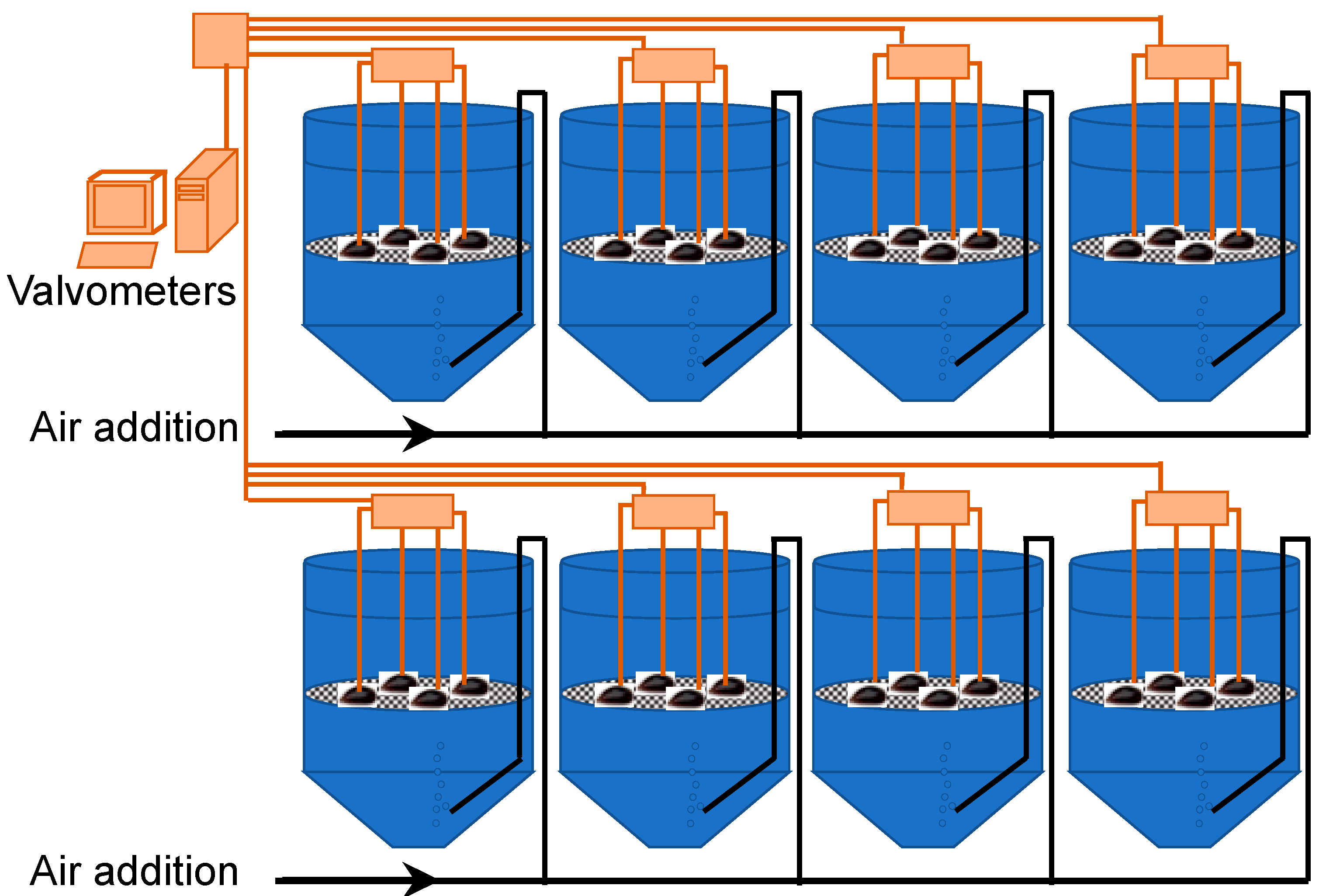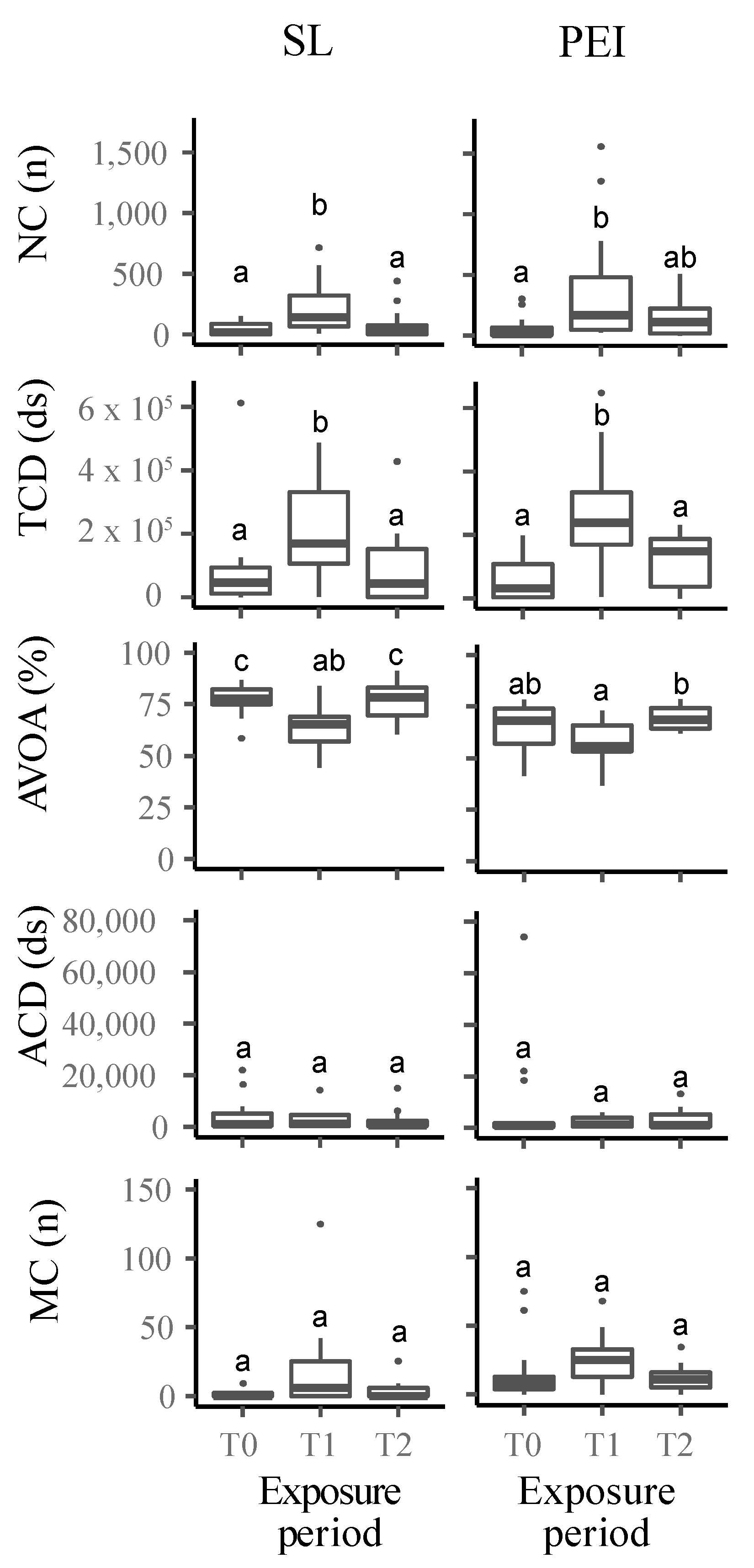Impact of the Toxic Dinoflagellate Alexandrium catenella on the Valve Movement of Mytilus edulis: A Comparison between Two Populations with Contrasting Histories Exposure
Abstract
:1. Introduction
2. Materials and Methods
2.1. Animal Collection
2.2. Experimental Design
2.3. Valvometry
2.4. Statistical Analysis
3. Results
Variation within Behavioural Indicators
4. Discussion
Author Contributions
Funding
Data Availability Statement
Acknowledgments
Conflicts of Interest
References
- Anderson, D.M.; Cembella, A.; Hallegraeff, G.M. Physiological Ecology of Harmful Algal Blooms; Ecological Sciences; Anderson, D.M., Cembella, A., Hallegraeff, G.M., Eds.; Springer: Berlin/Heidelberg, Germany, 1998. [Google Scholar]
- Blasco, D.; Levasseur, M.; Bonneau, E.; Gelinas, R.; Packard, T.T. Patterns of paralytic shellfish toxicity in the St. Lawrence region in relationship with the abundance and distribution of Alexandrium tamarense. Sci. Mar. 2003, 67, 261–278. [Google Scholar] [CrossRef]
- Lilly, E.L.; Halanych, K.M.; Anderson, D.M. Species boundaries and global biogeography of the Alexandrium tamarense complex (Dinophyceae). J. Phycol. 2007, 43, 1329–1338. [Google Scholar] [CrossRef]
- Fauchot, J.; Levasseur, M.; Roy, S.; Gagnon, R.; Weise, A.M. Environmental factors controlling Alexandrium tamarense (dinophyceae) growth rate during a red tide event in the St. Lawrence Estuary (Canada). J. Phycol. 2005, 41, 263–272. [Google Scholar] [CrossRef]
- Starr, M.; Lair, S.; Michaud, S.; Scarratt, M.; Quilliam, M.; Lefaivre, D.; Robert, M.; Wotherspoon, A.; Michaud, R.; Ménard, N.; et al. Multispecies mass mortality of marine fauna linked to a toxic dinoflagellate bloom. PLoS ONE 2017, 12, e0176299. [Google Scholar] [CrossRef] [PubMed]
- Boivin-Rioux, A.; Starr, M.; Chassé, J.; Scarratt, M.; Perrie, W.; Long, Z. Predicting the Effects of Climate Change on the Occurrence of the Toxic Dinoflagellate Alexandrium catenella along Canada’s East Coast. Front. Mar. Sci. 2021, 7, 608021. [Google Scholar] [CrossRef]
- Ahmed, F.E. (Ed.) Seafood Safety. Committee on Evaluation of Safety of Fishery Products, Food and Nutrition Board; National Academy Press: Washington, DC, USA, 1991; 432p. [Google Scholar]
- Shumway, S.E. A Review of the Effects of Algal Blooms on Shellfish and Aquaculture. J. World Aquac. Soc. 1990, 21, 65–104. [Google Scholar] [CrossRef]
- Matsuyama, Y.; Shumway, S. Impacts of harmful algal blooms on shellfisheries aquaculture. In New Technologies in Aquaculture: Improving Production Efficiency, Quality and Environmental Management; Woodhead Publishing Limited: Sawston, UK, 2009; pp. 580–609. [Google Scholar] [CrossRef]
- James, K.J.; Carey, B.; O’Halloran, J.; Van Pelt, F.N.A.M.; Škrabáková, Z. Shellfish toxicity: Human health implications of marine algal toxins. Epidemiol. Infect. 2010, 138, 927–940. [Google Scholar] [CrossRef]
- Goverment of Canada. Canadian Shellfish Sanitation Program Manual. 2022. Available online: https://inspection.canada.ca/food-guidance-by-commodity/fish/canadian-shellfish-sanitation-program/eng/1527251566006/1527251566942?chap=0 (accessed on 29 November 2023).
- Andrewartha, S.; Elliott, N. Aquaculture Sentinels: Smart-farming with Biosensor Equipped Stock. J. Aquac. Res. Dev. 2015, 7, 1000393. [Google Scholar] [CrossRef]
- Comeau, L.A.; Babarro, J.M.F.; Riobó, P.; Scarratt, M.; Starr, M.; Tremblay, R. PSP-producing dinoflagellate Alexandrium minutum induces valve microclosures in the mussel Mytilus galloprovincialis. Aquaculture 2019, 500, 407–413. [Google Scholar] [CrossRef]
- Durier, G.; Nadalini, J.B.; Comeau, L.; Starr, M.; Michaud, S.; Tran, D.; St-Louis, R.; Babarro, J.M.F.; Clements, J.C.; Tremblay, R. Use of valvometry as an alert tool to signal the presence of toxic algae Alexandrium catenella by Mytilus edulis. Front. Mar. Sci. 2022, 9, 987872. [Google Scholar] [CrossRef]
- Dame, R.F.; Kenneth, M.J. Ecology of Marine Bivalves: An Ecosystem Approach; Taylor & Francis: Abingdon, UK, 2011. [Google Scholar]
- Martin, M.; Richardson, B.J. Long term contaminant biomonitoring: Views from southern and northern hemisphere perspectives. Mar. Pollut. Bull. 1991, 22, 533–537. [Google Scholar] [CrossRef]
- Bricelj, V.M.; Connell, L.; Konoki, K.; MacQuarrie, S.P.; Scheuer, T.; Catterall, W.A.; Trainer, V.L. Sodium channel mutation leading to saxitoxin resistance in clams increases risk of PSP. Nature 2005, 434, 763–767. [Google Scholar] [CrossRef] [PubMed]
- Bricelj, V.M.; MacQuarrie, S.P.; Twarog, B.M.; Trainer, V.L. Characterization of sensitivity to PSP toxins in North American Populations of the softshell clam Mya arenaria. Harmful Algae 2004, 2002, 172–174. [Google Scholar]
- MacQuarrie, S.P.; Bricelj, V.M. Behavioral and physiological responses to PSP toxins in Mya arenaria populations in relation to previous exposure to red tides. Mar. Ecol. Prog. Ser. 2008, 366, 59–74. [Google Scholar] [CrossRef]
- Bates, S.S.; Beach, D.G.; Comeau, L.A.; Haigh, N.; Lewis, N.I.; Locke, A.; Martin, J.L.; McCarron, P.; McKenzie, C.H.; Michel, C.; et al. Marine harmful algal blooms and phycotoxins of concern to Canada. Can. Tech. Rep. Fish. Aquat. Sci. 2020, 3384, 322. [Google Scholar]
- Smith, G.K.; Guichard, F.; Petrović, F.; McKindsey, C.W. Using spatial statistics to infer scales of demographic connectivity between populations of the blue mussel, Mytilus spp. Limnol. Oceanogr. 2009, 54, 970–977. [Google Scholar] [CrossRef]
- Parkhill, J.P.; Cembella, A.D. Effects of salinity, light and inorganic nitrogen on growth and toxigenicity of the marine dinoflagellate Alexandrium tamarense from northeastern Canada. J. Plankton Res. 1999, 21, 939–955. [Google Scholar] [CrossRef]
- Nagai, K.; Honjo, T.; Go, J.; Yamashita, H.; Seok, J.O. Detecting the shellfish killer Heterocapsa circularisquama (Dinophyceae) by measuring bivalve valve activity with a Hall element sensor. Aquaculture 2006, 255, 395–401. [Google Scholar] [CrossRef]
- Almada-Villela, P.C.; Davenport, J.; Gruffydd, L.D. The effects of temperature on the shell growth of young Mytilus edulis L. J. Exp. Mar. Biol. Ecol. 1982, 59, 275–288. [Google Scholar] [CrossRef]
- R Core Team. R: A Language and Environment for Statistical Computing; R Foundation for Statistical Computing: Vienna, Austria, 2021; Available online: https://www.R-project.org/ (accessed on 29 November 2023).
- Oksanen, J.; Blanchet, F.G.; Friendly, M.; Kindt, R.; Legendre, P.; Mcglinn, D.; Minchin, P.R.; O’hara, R.B.; Simpson, G.L.; Solymos, P.; et al. Community Ecology Package: Ordination, diversity and dissimilarities. Vegan Community Ecol. Packages 2019, 2, 1–297. [Google Scholar]
- Martinez Arbizu, P. Pairwiseadonis: Pairwise Multilevel Comparison Using Adonis, R Package. version 0.3; GitHub, Inc.: San Francisco, CA, USA, 2019. [Google Scholar]
- Babarro, J.M.F.; Carrington, E. Attachment strength of the mussel Mytilus galloprovincialis: Effect of habitat and body size. J. Exp. Mar. Biol. Ecol. 2013, 443, 188–196. [Google Scholar] [CrossRef]


| Indicator | Factor | DF | Pseudo-F | p-Value |
|---|---|---|---|---|
| Number of Closure | Mussel population | 1 | 3.366 | 0.07 |
| Period | 2 | 10.632 | 0.0001 | |
| Interaction | 2 | 0.96 | 0.403 | |
| Total Closure Duration | Mussel population | 1 | 0.225 | 0.637 |
| Period | 2 | 16.958 | 0.0001 | |
| Interaction | 2 | 0.285 | 0.754 | |
| Average Valve Opening Amplitude | Mussel population | 1 | 19.49 | 0.0001 |
| Period | 2 | 16.726 | 0.0001 | |
| Interaction | 2 | 1.208 | 0.303 | |
| Microclosure | Mussel population | 1 | 0.041 | 0.949 |
| Period | 2 | 0.969 | 0.457 | |
| Interaction | 2 | 0.464 | 0.808 | |
| Average Closure Duration | Mussel population | 1 | 0.809 | 0.55 |
| Period | 2 | 1.505 | 0.123 | |
| Interaction | 2 | 0.546 | 0.824 |
Disclaimer/Publisher’s Note: The statements, opinions and data contained in all publications are solely those of the individual author(s) and contributor(s) and not of MDPI and/or the editor(s). MDPI and/or the editor(s) disclaim responsibility for any injury to people or property resulting from any ideas, methods, instructions or products referred to in the content. |
© 2023 by the authors. Licensee MDPI, Basel, Switzerland. This article is an open access article distributed under the terms and conditions of the Creative Commons Attribution (CC BY) license (https://creativecommons.org/licenses/by/4.0/).
Share and Cite
Durier, G.; Comeau, L.A.; Babarro, J.M.F.; Starr, M.; Clements, J.C.; Tremblay, R. Impact of the Toxic Dinoflagellate Alexandrium catenella on the Valve Movement of Mytilus edulis: A Comparison between Two Populations with Contrasting Histories Exposure. Coasts 2023, 3, 426-433. https://doi.org/10.3390/coasts3040026
Durier G, Comeau LA, Babarro JMF, Starr M, Clements JC, Tremblay R. Impact of the Toxic Dinoflagellate Alexandrium catenella on the Valve Movement of Mytilus edulis: A Comparison between Two Populations with Contrasting Histories Exposure. Coasts. 2023; 3(4):426-433. https://doi.org/10.3390/coasts3040026
Chicago/Turabian StyleDurier, Guillaume, Luc A. Comeau, José M. F. Babarro, Michel Starr, Jeff C. Clements, and Réjean Tremblay. 2023. "Impact of the Toxic Dinoflagellate Alexandrium catenella on the Valve Movement of Mytilus edulis: A Comparison between Two Populations with Contrasting Histories Exposure" Coasts 3, no. 4: 426-433. https://doi.org/10.3390/coasts3040026
APA StyleDurier, G., Comeau, L. A., Babarro, J. M. F., Starr, M., Clements, J. C., & Tremblay, R. (2023). Impact of the Toxic Dinoflagellate Alexandrium catenella on the Valve Movement of Mytilus edulis: A Comparison between Two Populations with Contrasting Histories Exposure. Coasts, 3(4), 426-433. https://doi.org/10.3390/coasts3040026





